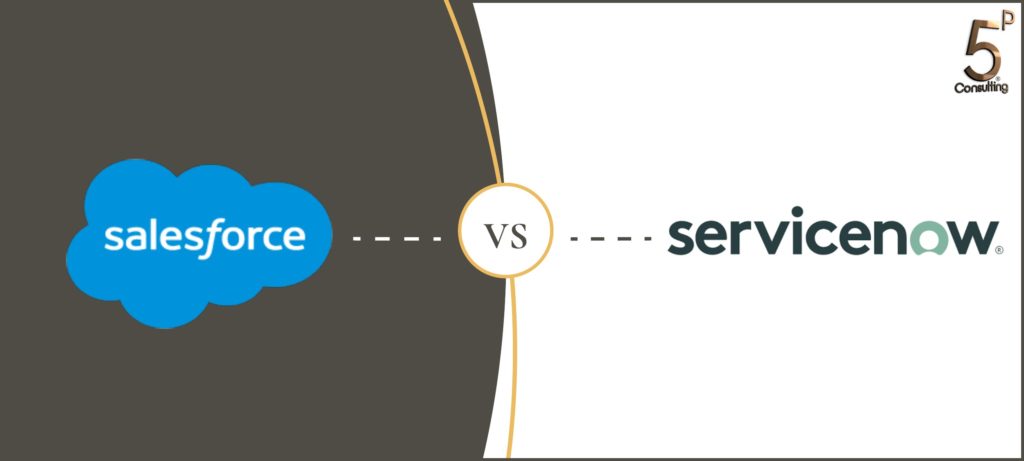
By: Randy Jasinski, President of 5P Consulting
Have you ever hopped on a software comparison tool to search for a solution to support your customer service operations? I bet you came up with hundreds of results. Search Capterra, a well-known

software comparison tool, for ‘Customer Service Software’ and you’ll get 269 available options; can you imagine how much time it will take to sift through and thoroughly research those results?
When it comes to narrowing down and selecting a vendor to take your company into the next generation of customer service where do you begin? As a Consulting strategist, I spend much of my time working with companies to re-engineer their customer engagement practices and define and deliver modern-day platforms to improve customer satisfaction (CSAT). Central to this journey is to determine the best fit of customer service technology vendors prior to any implementation.
At 5P we have extensive experience in Salesforce and ServiceNow; both leaders in Customer Service Management (CSM) on the Gartner Magic Quadrant. but the strategic goals of your organization, the specific requirements, your industry, cost, and ability of your organization to support next-generation processes are all important factors to get you to the best decision on which platform is the best for your organization.
Let’s look at these two key players and compare the factors that drive an organization to its decision:
Salesforce
- Salesforce Service Cloud is inherently integrated into Salesforce CRM out-of-the-box. If you already use Salesforce for your sales process then you will achieve a 360-degree view of data including marketing campaigns, opportunities, cases, and even orders. This can be a significant benefit by having detailed insight into your customers on a centralized platform. Use the power of Artificial Intelligence (Salesforce Einstein) and you can take it to the next level for predictive analytics and customer self-service such as end-user bots.
- Salesforce has extensive third-party ‘App Exchange’ apps to get just about any feature you can think of. This will allow you to take advantage of the hard work others have put into building a solution without custom building it yourself.
ServiceNow
- ServiceNow excels at process workflow and usability. At heart, they are a ticketing process system and this is where they excel. They’ve leveraged their extensive background in ITIL and deployed it for Customer Service Management (CSM) as well as other modules within their system.
- They have a simple model to understand and deploy. Their solution ‘can’ be less complex to implement but that will certainly depend on following their outlined path. It can get complex to configure so make sure you have the right skills to implement it.
- For many of my clients, I have found that ServiceNow can have fewer long-term support needs than Salesforce. If you follow the simple path then this tool is great. If you want more customized features, that’s when you would bring in a partner to assist.
COMPANY SIZE & INDUSTRY
- Your company’s size will be a factor in the decision process as well. Both are well established for enterprise clients, but for small (and some midsize) companies, Salesforce offers a solution called ‘Essentials’ that includes a basic ticketing solution, and as your business grows and matures you can grow with Salesforce over time. It is important to note that Essentials is a very limited tool, but a good starting point for any company needing a basic customer ticketing system.
- Industry is a factor that can drive the decision as well. Infrastructure or technology organizations may find ServiceNow a better fit since those industries’ processes tie so closely to typical ITIL processes. Organizations that are highly case-centric service organizations that are asset-intensive may find ServiceNow more directly in line with their requirements.
- Salesforce has recently launched their industry-specific solutions targeting various vertices and pre-building solutions for industries such as healthcare, finance, and manufacturing. This new approach is something that we will be watching closely as it evolves and matures, but they do have specific success stories that reflect the success they are already seeing.
IMPLEMENTATION
Salesforce
- The Salesforce straight-line processes are easy to implement.
- For companies already using Sales Cloud then usability will be a no-brainer because the UI and IT resources needed are the same across the platform making support and adoption simple.
- Salesforce’s customer engagement portal is called Experience Cloud. Once deployed the customer has a centralized portal for anything within Salesforce including customer service activities (ticketing, knowledgebase Q&A, etc). Don’t underestimate Salesforce Experience Cloud complexities. You will likely need to do custom work here since out-of-box is clunky and frankly may not make sense in some areas. As an example, once you have tailored the portal to your needs, as you continue to change it, you may run into needing to do ‘rework’ if it isn’t thought through in advance.
ServiceNow
- If your company already uses ServiceNow ITSM for internal ticketing then your IT team will be ready to support ServiceNow CSM and/or HRSM case management since it is based on that foundation.
- Integration for ServiceNow can be very simple. ServiceNow has worked with other systems to create a connector into the SNOW system which creates a cleaner integration.
- If your organization is seeking improved customer 360 data or has a process tied between the close of a sale and case management then you will need to integrate ServiceNow with other systems such as CRM or ERP. To achieve this, you would need to work with a partner for the desired results.
- Upgrading ServiceNow is very simple. Select the services where the Upgrades are implemented by ServiceNow Support. This path is the easiest and performed by the ServiceNow Upgrade Team.
- ServiceNow offers both a Cloud and on-Premise version. The on-Premise versions are much older and are gradually being phased out. Companies are moving away from on-premise for that reason.
COST & SUPPORT
As we go through the process of evaluating the vendors, cost is often one of the primary drivers for vendor decision-making. Some considerations include the following:
Availability of resources. As a general statement, it is easier to find support for Salesforce vs. ServiceNow. In particular, it can be more challenging to find full-time employees who already have ServiceNow skills, so training may be needed. ServiceNow has a great community and Hi Portal that makes getting learning and internal support simplified.
For both platforms, you may find that you can leverage a pre-built tool a third party created on the app exchange. It is important to dive deep into both the actual capability of the tool, but also the pricing structure. Some of these can get expensive and not deliver what you want causing money to be wasted or less than optimal outcomes. Bottom-line, you get what you pay for.
For both vendors, pricing needs to be well thought out and negotiated prior to proceeding. This is when you have the most negotiation power and going back later and realizing you need additional features will cost you. In general, pricing shouldn’t be complex, but going into it with a lack of understanding of what your company needs, the tools offered by vendors, and how rapidly licensing costs can add up; it is important to have a strategy before you go too far.
VENDOR VISION
Both vendors are in the top quadrant of Gartner’s report and heavily invested in improving their tools and advancing technology. At 5P, we focus on these two vendors in this space in large part because both the vendor’s vision and heavy investment will continue to drive the market in the coming years.
One of the biggest investments is in automation and in particular, AI. According to Gartner, “by 2025, customer service organizations that embed AI in their multichannel customer engagement platforms will elevate operational efficiency by 25%”. Just a few years ago AI was considered science fiction or only for organizations willing to spend millions of dollars in technology and data scientists, but today and going forward AI can be leveraged by most organizations with modest investments.
The various components of predictive analytics and enabling customer self-service BOTS continues to mature. Salesforce’s Einstein platform has improved and they have numerous prebuilt tools such as BOTS that are simple to configure for any organization and they are effective. The future of AI is certain, but there is still a ways to go before most companies truly adopt it. This can be a game-changer or a red herring so make sure you understand what you are getting into before investing.
Both vendors have been furthering their platforms to target specific customer needs. Salesforce has recently launched its industry verticals. ServiceNow is also making inroads leveraging their ITSM foundation including specific features such as HRSM, Banking, and Retail.
CONCLUSION
There is no clear winner for choice. You will need to take the above considerations into account. I recommend methodically putting together a selection plan and using this plan top-down to drive the decision and pricing for both licensing, implementation, and long-term support.
References
Capterra Report – https://www.capterra.com/customer-service-software/compare/136189-192052/Salesforce-vs-ServiceNow-Customer-Service-Management
Gartner Report – https://www.gartner.com/doc/reprints?id=1-1Z6CEYL4&ct=200604&st=sb
Salesforce industry vertices – https://www.salesforce.com/solutions/industries/
ServiceNow Industry Solutions – https://www.servicenow.com/solutions/industry.htm
